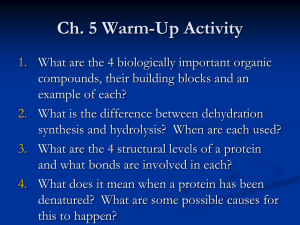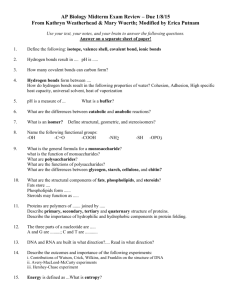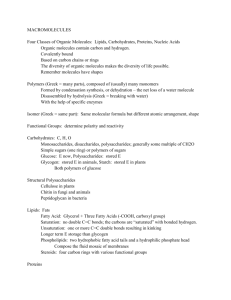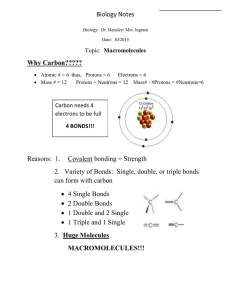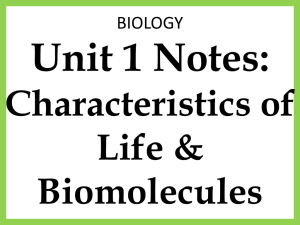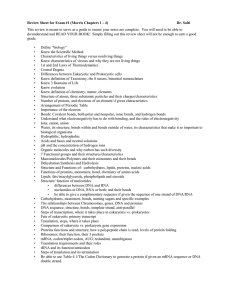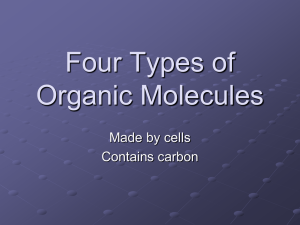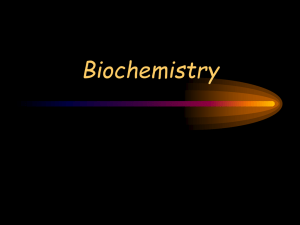Organic Molecules
advertisement
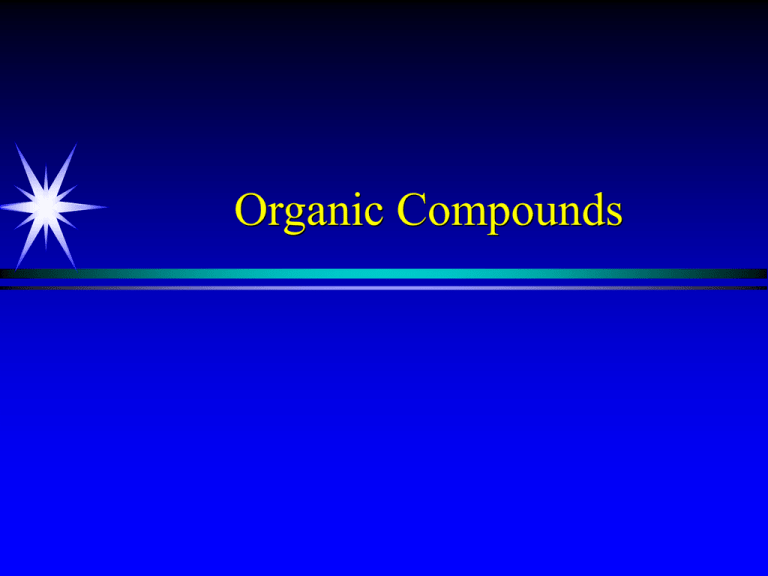
Organic Compounds • • • • • • Define isomer Define carbohydrate Define protein Define peptide bond Define enzyme Define amino acid • • • • What is meant by organic? Of and/or pertaining to life Organic food Food grown without the use of chemicals Role of Carbon • Usually contains carbon • Carbon’s electron shell configuration allow for four covalent bonds • Usually H, O, N, or another C • Single, double, or triple bonds • Can also form chains or rings which allows for many different arrangements 2 Methanes equal an Ethane • Monomers- basic units of organic molecule • Isomer- same chemical formula but different arrangement • Polymer- when two or more monomers H2O Four Organic Molecules • • • • Carbohydrates Lipids Proteins Nucleic Acids Carbohydrates • Contains carbon, and hydrogen and oxygen at the same ratio of water • 1:2:1 • Monosaccharides- simplest sugars • Disaccharides- when two join together • Polysaccharides- largest polymers of sugar • • • • Short to intermediate energy storage Starch in plants, glycogen in animals Cellulose used as structural material Energy is released when cells break down glycogen / starch • Condensation- water taken out (joins) • Hydrolysis- add water (break apart) Lipids • Fats, oils, and waxes • Contain H, C, and O but contain many more C-H bonds than O • That + non-polar = insoluble in water • Provide the most stored energy • Important in membrane which regulate what enter and exit cell • Many have a backbone of 3 carbon molecule= glycerol • Saturated= no double bonds • Fats; solid at room temp • Unsaturated= contain double bonds • Oils; liquid at room temp • Fat – insulation and energy storage • Phospholipids – plasma membranes • Steroids – sex hormones and cholesterol • Waxes – function to protect organisms Protein • Basic building blocks of all life • Additionally contain N, S, and others • Made up of monomers called amino acids • 20 essential amino acids form polypeptide bonds to form protein • Support – keratin (hair and nails) and collagen (structure for many organs) • Transport – channel and carrier proteins in plasma membrane • Defense – antibodies • Hormones – insulin • Motion – muscle fibers Enzymes • Catalysts that speed chemical reactions • Substrate fits into active site to produce product • Lock and Key Nucleic Acids • Carry all instruction for cellular activity • Polymers of nucleotides • Contain a base, a simple sugar, and a phosphate group • Two forms : DNA and RNA DNA • Deoxyribonucleic acid • DNA forms genetic code passed on from one generation to the next • The sugar used in DNA is deoxyribose • Double stranded RNA • Ribonucleic acid • Allows DNA to work by reading instruction and carrying them out • Use ribose as its sugar • Single stranded ATP • Adenosine triphosphate • Used in cells for energy requiring processes • Photosynthesis • Cellular respiration • “Energy currency”




